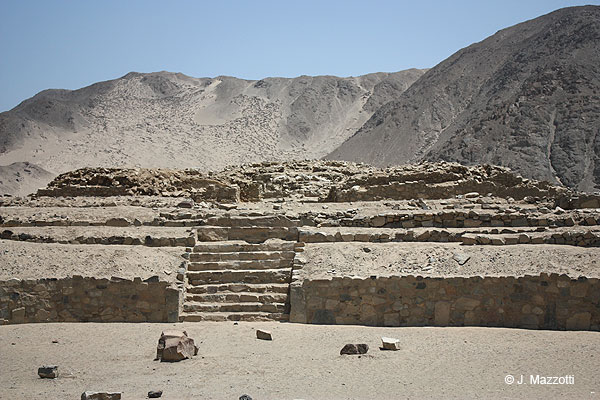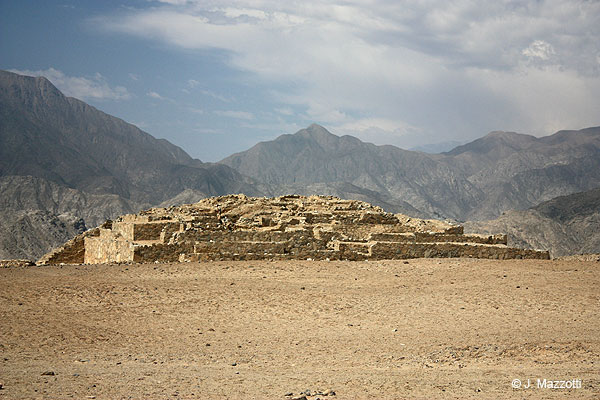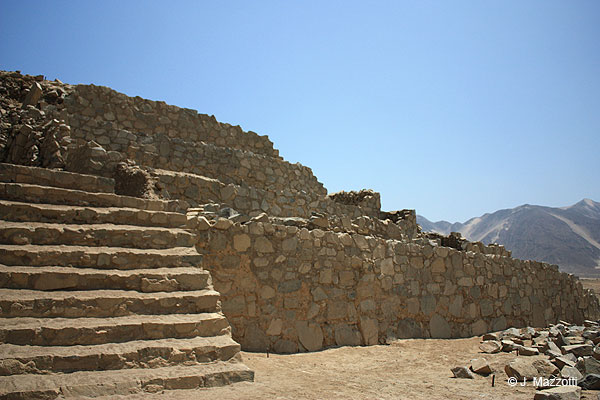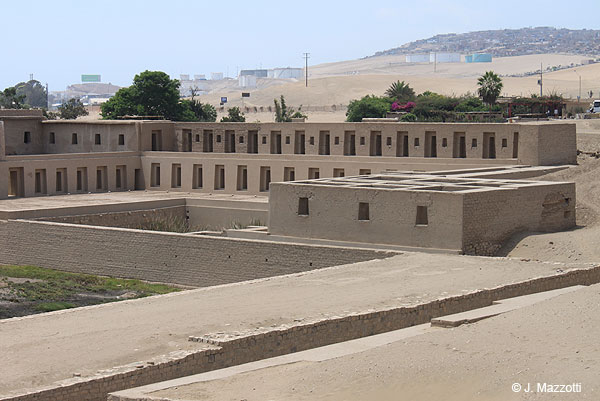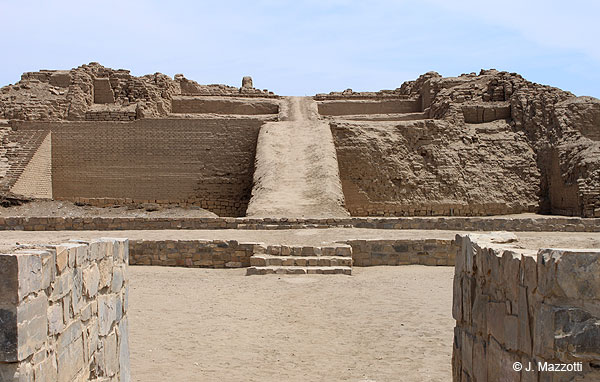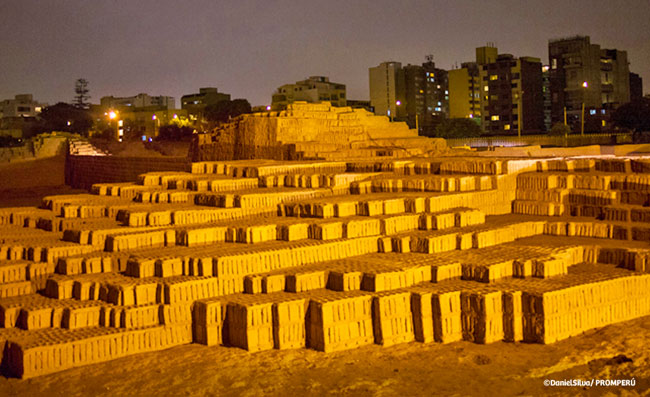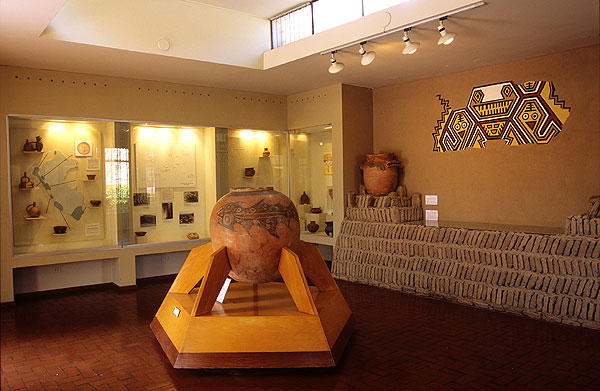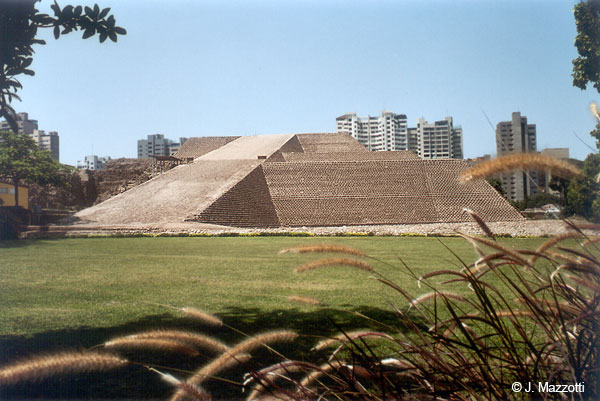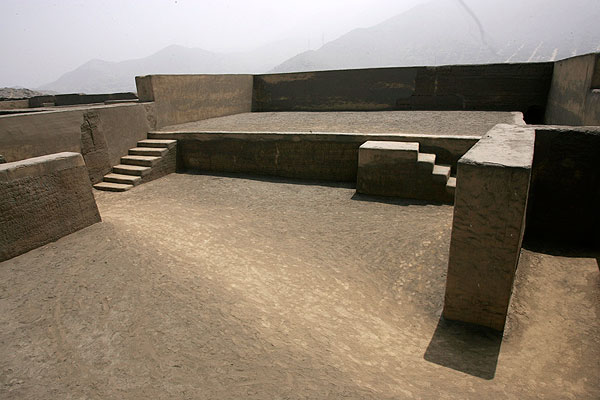Archaeological places in Lima

 In the valley of Lima, and others nearby, were developed several pre-Inca
cultures, and then was the domain of the Incas, who developed major urban and
religious centers, conserved and restored.
In the valley of Lima, and others nearby, were developed several pre-Inca
cultures, and then was the domain of the Incas, who developed major urban and
religious centers, conserved and restored.
Today you can visit archaeological places as Pachacámac, Puruchuco, Cajamarquilla, Huaca Pucllana, among others.
In 1994 was rediscovered the Sacred City of Caral, much earlier than the Incas and while civilizations like the Mesopotamian, Egyptian, Indian, and Chinese, having transformed the history as it is an archaeological site 5000 years old, its origins date back to the Late Archaic Period of the Central Andes and is the oldest centre of civilization in the Americas.
Between the years 200 and 700 a.C . The valley of Lima had a conjunction of ecosystems that made ideal for the formation of cultures, in spite of being in the middle of the Coastal desert. There used to be woods of guarangos, taras, molles and several fruit trees. The large Lumber of irrigation ditches and open channels formed their own riverside wood. What is more, the wetlands spread in the mouths of the Rivers, overall, in the southern zone of Lima, in the current districts of Chorrillos and Villa el Salvador until the delta of the river Lurín.
In the sea, there were a great abundance of resources and its exploitation permitted a great development of the civilizations that settled down there. The inhabitants of the coast populated hillocks and valleys, until they formed very complex worship and housing centers, the ones that gave origin to immense ceremonial centres such as Huacoy on the Chillón river, Garagay and the Florida on the Rímac river, Manchay in Lurín, Chancay, Supe and many other valleys of the north and the south.
Caral - The oldest city of America - World Heritage Site
The Sacred city of Caral has been declared a UNESCO World Heritage Site (2009). The site corresponds to the most ancient civilization in Peru and the Americas (5,000 years old). Together with Mesopotamia, Egypt, India, China and Mesoamerica, it is one of the cultures that allowed States, cities and great civilizations to flourish. Plazas at the foot of imposing pyramid constructions have been discovered. This is where inhabitants met to worship gods and exchange products, under the gaze of political and religious authorities.
The 5000-year-old 626-hectare archaeological site of The Sacred City of Caral - Supe is situated on a dry desert terrace overlooking the green valley of the Supe river. It dates back to the Late Archaic Period of the Central Andes and is the oldest centre of civilization in the Americas.
Exceptionally well-preserved, the site is impressive in terms of its design and the complexity of its architectural, especially its monumental stone and earthen platform mounts and sunken circular courts. One of 18 urban settlements situated in the same area, Caral features complex and monumental architecture, including six large pyramidal structures. A quipu (the knot system used in Andean civilizations to record information) found on the site testifies to the development and complexity of Caral society. The city’s plan and some of its components, including pyramidal structures and residence of the elite, show clear evidence of ceremonial functions, signifying a powerful religious ideology
The Sacred City of Caral - Supe is considered to be the cradle of civilization in the Americas. This archeological site of an urban settlement belonged to the complex and fully developed Supe state. It was constructed between 3000 - 1800 BC, in the same timeframe as the the works of the Ancient Egyptians and Mesopotamians.
The complexity of the Supe civilization is shown by the discovery here of the first quipu, a system of knots to record information. The site is seen as the “Mother Culture” of the Peruvian civilizations, that ended with the Inca. Caral - Supe was excavated relatively late, in 1994, although it had been discovered already in 1905.
Visiting Hours : Daytime.
Location: 206 Km north of Lima, deviation at kilometer marker 184 on the North Pan-American Highway.
Pachacámac
The Pachacámac oracle
Pachacámac, an ancient pre-Columbian oracle, dominates the fertile Lurin valley, 31 km south of Lima. This wellknown ceremonial center amazed the Spanish conquerors and undoubtedly the Incas themselves when they arrived at the coast.
Entirely built with adobe mud bricks, it ranked together with Cusco among the main religious centers of pre-Hispanic Peru. Pilgrims from the most remote palaces arrived there from the most remote places arrived there to pay homage to the Pachacámac God, creator of the world and its creatures.
The Inca section of the archeological compound (1440-1533) is the best-preserved area. The site includes palaces, squares and carefully restored temples and has a site Museum housing an interesting collection of artifacts.
Pachacámac was a pan-regional religious center whose origins remain little known. It seems to have been built as an important center of power at the beginning of the Early Intermediate Period.
Max Uhle, a reputed German archeologist, discovered a temple of that period whose facade was painted in red. This temple is known today as the Old Temple. Uhle´s findings, especially pottery and textiles, feature motifs from the Highlands, which in many cases are of clear High Plateau inspiration. Another construction named the Painted Temple was built at a later stage, maybe at the end of the Intermediate Horizon (ninth to tenth centuries AD). The name comes from the remains of the frescoes on its walls.
During the ninth to fifteenth centuries AD construction speeded up driven by the powerful ideology linked to the god honored at the side. The temple-palaces reminding us of the Near and Middle East zigurats and known as “ramp pyramids” date back to this time. Fifteen of these so called “provincial temples” have been identified. They were the fruit of the effort of several central Coast communities’ efforts to legitimize their belonging to a surprisingly prestigious religion. The coexistence of temples from different periods during this time and the presence of offerings coming from coastal areas contribute to the hypothesis that Pachacámac functions as an oracle (European chronicler of the sixteenth century narrate that the supreme deity was the Earth god Ichma). When the Incas settled in the central Coast, they acknowledged its power and effectively included it in their expansionist policies.
However, they also built a new sanctuary on the summit of the rocky hill: the imposing Temple of the Sun. From it we can observe the ceremonial center to the east and the Pacific Ocean to the west (as well as two nearby islands that have been Hispanic times). As a whole, Pachacámac represents one of the most important hubs in the long, complex and dynamic process of Andean regional integration.
There is a site museum with items discovered during excavations. Visiting Hours: Mon - Sun 9 am - 4 pm (site's museum). Location: 31 Km south of Lima, on the South Pan-American Highway (1 hour).
Huaca Huallamarca
(“huaca” means shrine) Located in the intersection of Avenida El Rosario and Avenida Nicolás de Rivera, San Isidro. Visiting hours: Tue. - Sun. 9:00 - 17:00. It is a pyramidal building with a central access ramp to the highest part of the building. Its occupation dates from the end of the Formative period (800 - 100 BC), with a solid consistent occupation after Lima culture (100 - 600 AC) and then sporadically to the Wari and Ichsma. Also called "Pan de Azúcar" (Sweet Bread) - highly restored. Site museum houses pieces found during the excavations of the area.
Huaca Pucllana or Juliana
Located in General Borgoño street, block 8 (Near Avenida Angamos Oeste, block 4 and Avenida Arequipa, block 45) in Miraflores. Visiting hours: Wed. – Mon. 9:00 – 17:00. It represents the power and political domain performed by a priestly group that in their period controlled the valleys of Chancay, Chillón, Rímac and Lurín. A ceremonial center dating from earliest stages of the Lima culture. Huaca with a pyramidal shape, pre-Inca adoration site dedicated to the God Pachacámac. Sometimes, events or musical shows take place there. You can also find a site museum that exhibits pieces found in the excavations. Amazing views of the illuminated ruins at night.
Puruchuco
(Quechua voice: Hat of feathers) Located at kilometer marker 4.5 of Carretera Central east of Lima. Visiting hours: Mon. - Sun. and holidays – 8:30 am. - 4:30 pm. This palacelike construction of the Late period (XV - XVI century AC), made of adobe tricks on a rectangular floor terrain, with Horizontal structures without artificial volume / pyramidal. Palace in which "caciques" (political chief of the city) or important people exercised domain over the valley of Rímac. The space is distributed along geometric lines and divided into three sectors, the most interesting being the area of patios and lookouts. During the excavation process, several mummies were recovered, characterized by being placed in a fetal position and accompanied by everyday objects. You will find an interesting site museum.
Cajamarquilla
Located at kilometer marker 10 Carretera Central, take the turnoff on the right hand side of the Rimac River and drive 5 Km (3 miles) lower part of the Jicamarca gorge, east of Lima, in the denominated place Huachipa. Inca archaeological complex, citadel with walled square, numerous barns or food deposits. It was built during the sixth and seventh centuries A.D., the period corresponding to the Lima culture. Its 167 hectares of mud buildings are considered the second largest among the pre-Hispanic Andean mud cities (after Chan Chan in Trujillo).
San Juan de Pariache
Located at 9.94 miles (16 Km) to the east of Lima. Inca archaeological location, of very similar construction to the archaeological center of Puruchuco.





